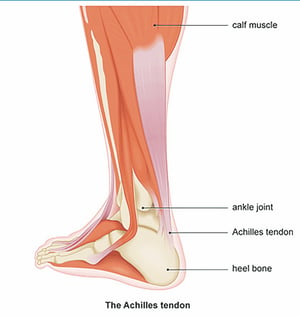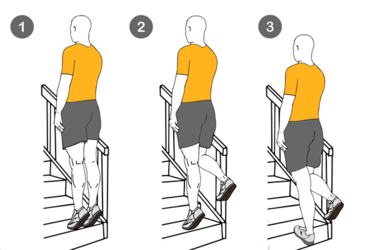How To Treat Achilles Pain With One Simple Exercise?

How To Treat Achilles Pain With One Simple Exercise?
The Achilles Tendon
The achilles tendon attaches the calf muscles to the heel and is an important part of transferring force to propel the leg forward during running.

Overuse of this tendon from repetitive motion can cause tendinopathy.
Achilles tendon pain is characterized by pain, swelling, and loss of function. This condition is most common in male runners aged thirty to fifty but can affect anyone who is physically active.
Always consult with a medical professional if you suspect you have an injury and before you begin a treatment program.
Am I at risk?
Common intrinsic risk factors for an achilles injury include:
- loss of ankle range of motion
- increased foot pronation
- high arches, ankle instability
- old age
- obesity
- diabetes
- arthritis
- leg length inequality
Common extrinsic risk factors include:
- changes in training patterns
- hill training
- poor technique
- high intensity plyometric exercise
- improper footwear
- previous injury
- corticosteroid use.
How will I know if I have an achilles problem?
A health care provider can properly assess and diagnose your problem and get you on the path to treatment.
Achilles tendon pain and injuries commonly present with pain related to exercise that can occur at the back of the heel or the back of the lower leg.
Stiffness often occurs when standing on the leg after a period of immobility or after/during exercise.
Swelling may occur at the back of the leg and may make it difficult or painful to wear shoes. Patients will commonly note decreased leg strength and endurance.
What can I do to avoid this?
While some risk factors can not be controlled for like old age and diabetes, there are a lot of things you can do to avoid achilles injuries.
These include:
- regular exercise
- weight management
- strength training
- proper footwear
- proper training patterns and intensity
One of the most common factors involved in Achilles tendon injuries is overuse and sharp increases in training intensity.
Be sure to give your achilles time to recover between training sessions and increase running distance incrementally over time.
How is Achilles pain treated?
Initial management of an achilles is conservative care. This includes but is not limited to ice, activity modification, exercise, physical therapy, and foot/ankle support.
More invasive options are available if conservative care is not effective and include low level laser therapy, shockwave therapy, and in extreme cases surgery.
Soft-tissue management and chiropractic care for achilles pain is also beneficial.
What exercises should I be doing?
The most commonly prescribed and most effective exercise for Achilles pain is eccentric strengthening exercise.
An eccentric exercise is a muscle contraction as the muscles elongate rather than shorten. Consider adding stretching exercises to increase ankle range of motion.
How do I do eccentric calf raises?
- Start in a single leg standing position with your weight on the forefoot with your foot planted on a raised surface like a stair or a box and your heel hanging off the edge.
- Slowly lower the heel into a dorsiflexed position then hold that position for 1 second.
- Return the heel to the starting position using your arms and other leg to power yourself back up.

This avoids concentrically activating the calf muscles. Be sure to move in a slow and controlled manner and maintain balance.
Start with sets of 3 and 10 repetitions and let pain be your guide for decreasing or increasing load. Over time consider increasing repetitions and adding weight.
Will I get better?
The majority of patients respond well to a trail of conservative care with an estimated 70-100% of individuals returning to prior activity with few or no complaints.
Prognosis is generally better in the athletic young population so remember to stay active!
What is the normal healing progression and what can I expect?
Achilles tendon pain healing typically follows a predictable progression. The initial acute phase lasts a few days with pain, swelling, and loss of function following a trauma or overuse injury.
The second phase lasts around 3 weeks and is accompanied by new collagen production and new blood flow to the area. This stage is very important as collagen is laid down in the direction of force applied to the area.
This stage is vital as starting exercise will help your body organize the new tissue optimally so you maintain function.
The final stage is the remodelling phase and can last months to years after.
It is important to maintain Chiropractic treatment in this stage as while the new collagen tissue is stronger than the previous tissue it is not as functional. This means improper treatment can lead to decreased function.
What should I do now that I am feeling better?
A major risk factor for developing Achilles Pain is a previous achilles tendinopathy. It is important to learn from previous experience to prevent future injury.
This means avoiding over training and consulting with professionals to avoid overuse. As well as maintaining regular exercise and strength training to keep your achilles healthy and strong.
If you have Achilles pain, meet with one our Chiropractors and see if Chiropractor care is the right fit for you.
For more information and topics on chiropractic care visit our chiropractor services page.
FAQ
What causes Achilles tendon pain?
Achilles tendinopathies commonly present with pain related to exercise that can occur at the back of the heel or the back of the lower leg.
How to treat Achilles pain?
Initial management of an achilles is conservative care. This includes but is not limited to ice, activity modification, exercise, physical therapy, and foot/ankle support.
What is the best exercise for Achilles pain?
The most commonly prescribed and most effective exercise for Achilles pain is eccentric strengthening exercise.
References:
-
DynaMed [Internet]. Ipswich (MA): EBSCO Information Services. 1995 - . Record No. T114274, Achilles Tendinopathy; [updated 2018 Nov 30, cited Novemebr 27 2020]. Available from https://www.dynamed.com/topics/dmp~AN~T114274. Registration and login required.

